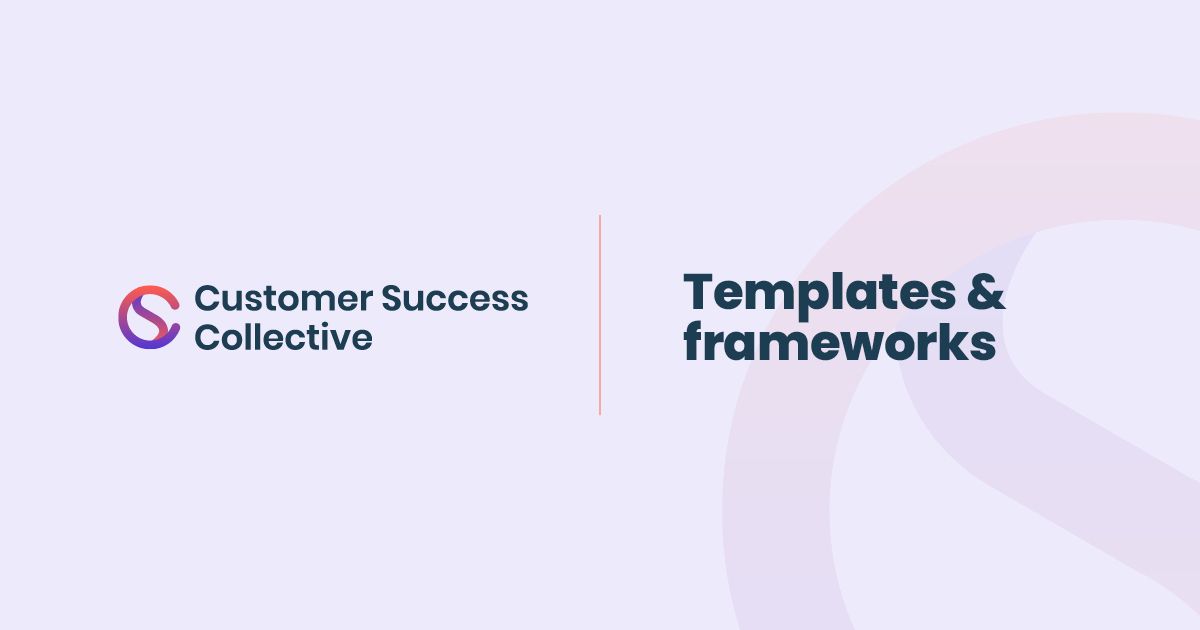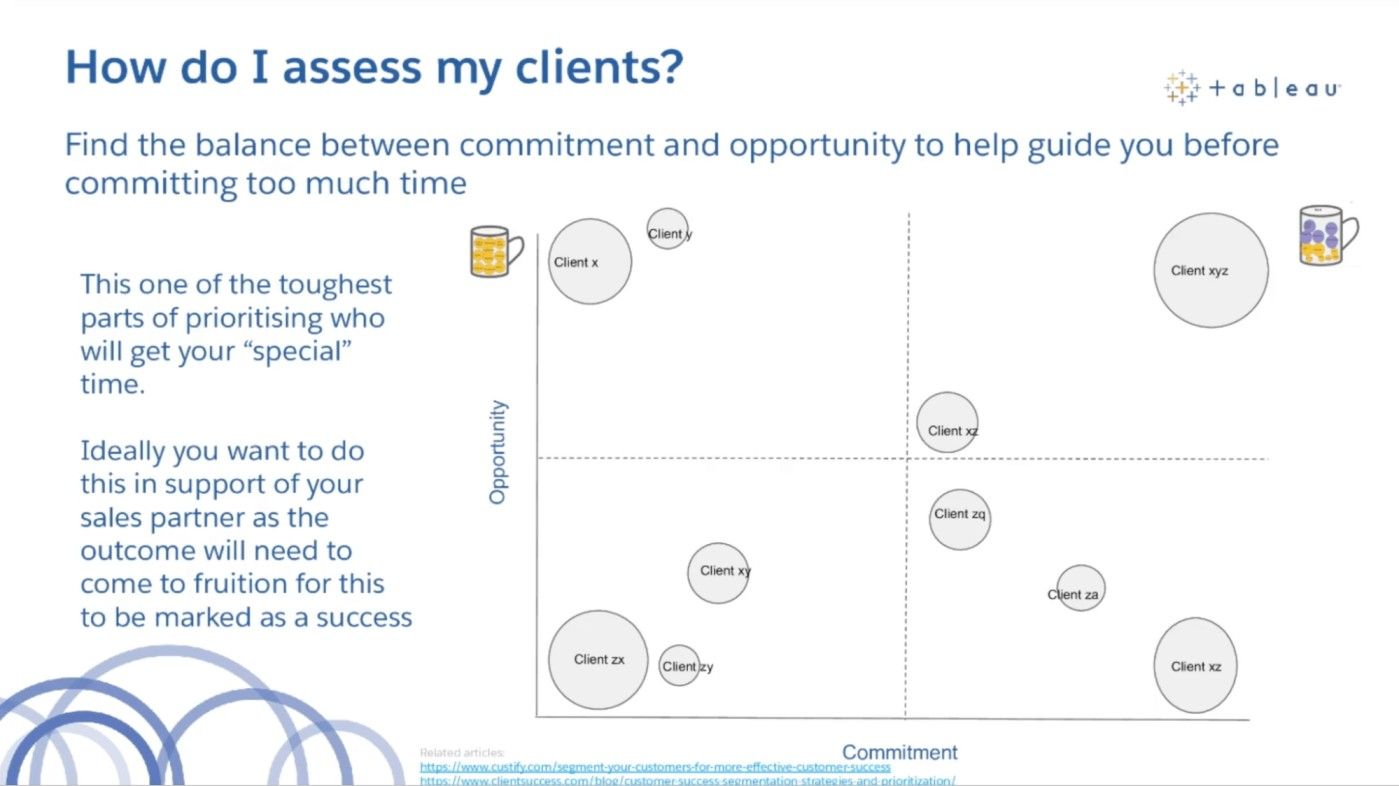This article has been transcribed from a presentation given at the Virtual Customer Success Festival in March 2022. At the time of recording, Ralph worked at Tableau; as of April 2022, Ralph joined Procore Technologies as an Enterprise Customer Success Manager.
My name is Ralph Meyer, and I'm a Principal Customer Success Manager at Tableau, a Salesforce company. My remit is Europe-wide, and one of the key things that may be different about my role is that I focus largely on strategic customers. On my journey so far as a CSM, I’ve focused on small-to-medium-sized business (SMB) clients, then enterprise clients, through to the strategic clients I work with today.
In this article, I'm going to be talking about ‘going deep to go wide’. It’s about value and scale and trying to get those two things to work together. I have to admit it's a tricky balance. I prefer the value piece, and I tend to avoid scale as much as I can, but I recognize that scale pays the bills so we can’t ignore it.
With that in mind, I'm going to open with a quote from Jeff Weiner, the previous CEO at LinkedIn. I'm not really into quotes, but this one sits well with me:
“Trust equals consistency over time.”
Every time I reflect on relationships or client engagements I've had, this quote always rings true. Delivering on time, being consistent, and being predictable are the keys to building a strong partnership with a client.
That partnership is going to be a common theme across the case studies that we'll cover today. There are two case studies, each with a very slant, and both of them are about going deep but with different results. I'll also cover some of the methodologies that shaped how I was thinking about those clients.
Case study one: A long-term view
My first case study is an interesting one. The client is a household name in the world of fast-moving consumer goods (FMCG). I can't share the brand, unfortunately, but the chances are you've consumed their products.
We found ourselves in an interesting situation with this particular client, where we recognized the strategic value of their account, but they weren't very well penetrated. In fact, when I inherited this account, we pretty much only had a presence on the EMEA side of their business.
One of the things that stood us in good stead here was that we had an enthusiastic champion in EMEA who knew our potential. However, the client was changing their business a bit. They were offshoring some of their services, reinventing their technology stack, and figuring out what good looked like for them.
They were also working with multiple brands within their portfolio, trying to bring together a concise strategy where there hadn’t been one before. That's where we came in. They invested about $400k with us, which was significant in my book at that stage, and that's where we kicked things off.
This customer had so many spinning plates and agendas, that it would have been quite easy for me as a CSM just to say, “Hey, man. Here's my product. Good luck and Godspeed. I'll see you at the next ops review.” Or, I could have taken the tack of saying, “My product does X. That's the only thing it does,” and not gotten involved with any other initiatives.
What I did differently
Instead, I chose a different route. I chose to go a little bit deeper. As an example, part of my role in the offshoring initiative was to make sure that the people on that team were equipped to use our product to deliver results. I was also there to hold them accountable for the things we said we’d do. This was fantastic because our champion suddenly knew that she could rely on me to take that view and help get those offshored services to work correctly.
The issue I had was that this was a complex environment, and our champion had to report to her leaders on strategy and data trends, but she just didn't have the capability available to her.
I was very fortunate to have analysts reporting to me, so I asked them how we could build something to make that reporting easier. We showed her how, if she took our tool and adjusted it a little bit, she’d be able to see her risks and opportunities, and she could start to plan a strategy and see her deliverables coming to fruition – all of those things that had been missing just fell into place.

The challenge
So imagine this – we worked with them on this platform, and word started to travel up the chain of command. It went from manager to director to VP to C-Suite, and they said, “We like what you guys are doing in Europe. Could you do this for the rest of our business?”
I mean, Europe is one thing, but a whole 250,000-person organization is a whole different league of trouble, right?
Anyway, we said, “Yeah, let's do it,” and they signed a wall-to-wall deal with us. The investment went from $400k to $1.7 million. Yikes! All of a sudden, instead of having one EMEA lead, I had seven leads for wall-to-wall solutions, and we had to make it work.
Europe is a complex environment. While it was quite easy to retrofit our solution for different countries, we weren't prepared for how different the zones were in terms of maturity and their journey using our product sets.
Consequently, we had to get into the weeds to figure out what would work in those different zones to help them not only be able to report up to the VP level but also bring a concise global view to 98 different brands doing 98 different things. We needed information to be able to flow up and down so that not only could the C-Suite make decisions but VPs and regional leads could transact on those decisions too.
This was so successful that the Chief Human Resources Officer (CHRO) started using us as a source of truth for data that would allow them to identify areas of opportunity, risks, and expansion, and do due diligence for mergers and acquisition activities. That's got nothing to do with my product, by the way, these are just some things that our input started to contribute towards.

Next thing we knew, thanks to this success, we started being invited to purchasing committees and forums to see how we could push the client’s agenda forward for the next five years. I was just the dude selling products and making them work, so to be involved with this kind of thing was way off-piste for me, but there I was.
Mini recap
Let’s recap our journey with his client so far. In year one we got started with EMEA. In year two, we started work on the global piece. In year three, we got recognition as a secure strategic resource that needed to be fostered. The annual investment went up to $2.3 million per year for wall-to-wall all-you-can-eat solutions, and we had significant rollouts of different technical integrations.
You might be thinking, “Hang on – did you triple the size of your team?” The answer is no. It was the same team I had three years earlier. We were just very careful about what we got involved with and managed our portfolio of activities to create a balance in terms of what we could deliver.
That was a pretty cool scenario, and it certainly goes in my history book as one of my proudest moments. If I were to rewind this whole scenario, I could have chosen to just focus on my product’s core capabilities and left the client to it, but then I would have never gotten the credibility or the air time to reach those echelons.
That's the theme I'm trying to get to with this: it’s all about scale and value. However, scale and value mean different things to different people. For me, value means making it easy to take something small and grow it, while keeping our service consistent. I look at scale as the cost to serve. It’s about how I reduce that number as much as possible and keep my managers happy.

What type of relationship do we need?
If I was to look at a CSM’s time as some kind of vessel with a finite capacity – a cup or a bucket, perhaps – what should I fill that time with? Chasing tickets? Renewals? Self-service activities? Reporting? I guess that's what I could do. That's what a CSM does, after all; we make sure that everything is hunky dory, right?
But what I really want to work on are things like organizing events, blue sky thinking, multi-threading (multi-threading, in case you don't know, is creating relationships with multiple stakeholders to spread your risk), partnering, and building trusted adviser status.
I quickly realized that because I have a finite amount of time, I had to rethink the way I was expected to work as well as what I was serving to my customer. With that in mind, I tried to take some of that noise away. I asked permission from my customer to make decisions without always having to ask for their input, and I got their blessing.
We took things like licensing, compliance, and usage limits away from the clients entirely and made them work. We cut out all that noise so that, from their perspective, working with us was a doddle. Then, during meetings, I started drip-feeding some of those cool things like partnering, multi-threading, and the trusted advisor stuff, because that's where I wanted to play.
That's essentially what we did on that journey. In phase one, we created that space. In the second phase, we already had that space – we just had to replicate it. Then, by the third phase, we already had robust processes in place, so as far as the client was concerned, doing business with us was really easy.

Case study two: When it matters most, jump in!
I want to switch gears to a topic that’s probably a bit more uncomfortable for some of us – we’re going to see where the boundary lies between going deep and staying wide.
I don't know if you've ever had a client ring you up in a desperate state, and you can't necessarily help them, but you feel for them. That's where I found myself in this particular case study.
For context, this was another FMCG client with a global presence and about 90,000 employees. They had $350K’s worth of investment with us, and one of the things that were great about this client is we always used to bounce ideas off each other – we had a great rapport that we’d built over a couple of years.
One day, I got a phone call, and I could tell from the client’s voice that they weren't in a good place. Something wasn't right, so I asked what was going on. She said, “I've just had the worst meeting with our finance team.”
It turns out they were going to shut down the ERP system for four weeks for essential maintenance to reflect the new organizational structure. Consequently, the HR system would be down for the same period. That doesn’t sound so bad – it's only four weeks – until you realize that the HR system ran things like payroll, hiring, contract offers, and legal compliance. The kicker was she got only one week’s notice to get all that stuff in order.
At the end of the call, I had to tell her that I wasn’t sure that I’d be able to do anything to help, but I’d have a think about it. That night, I barely slept because her story was running through my mind.
The next day, I asked my colleagues if we could possibly accommodate some of our client’s efforts by shifting our product a little bit to use it in a way that it wasn't intended for. The answer was yes. We could make it work. My team was on board because we’d been working with this client for so long and we had a great partnership.
I called the client the next day and told them that we had a few ideas for how we could do some of the heavy lifting so they could concentrate on resolving the other problems. I said we’d work as fast as we could to get our modified system up and running for them within a week.

Within a week, we’d loaded 128 templates onto the system – we didn't ask them to do it because it would take too long. We also ran workshops with 97 members of their team to talk them through the process and show them how to work around various tasks while their ERP was down.
On top of that, we did a quick audit to see if this system would be legally compliant in the different regions they were working in, making sure that if an audit was ever required, there would be a sufficient audit trail and they could avoid finding themselves in a legally untenable position.
Off we went. Four weeks went by, and we had zero tickets raised. The process worked – yay! The end users never noticed a thing, which was the intent.
It was so well that the client decided that while the old system was down, it would be a good time to do some essential maintenance in their CRM to reflect their organizational changes and new cost centers. They extended the downtime from four weeks to eight weeks, and when we switched everything on, it went seamlessly. I was like, “Thank goodness! What a palaver. We're done.”
Or so I thought.
Three months later, we got an email from the CHRO commending us and saying, “We can't believe how fantastically you partnered with us, so much so we're going to recognize you as a fail-safe technology,” and they put aside $80,000 to purchase additional resources from us and ensure that the fail-safe was robust enough and could be maintained. We were blown away. We could not believe that we had landed $80k of additional revenue just from a week’s graft.
But the thing that was most impressive to me is that, because we didn't have any downtime and we were maintaining their data and making sure it continued being fed into our system, all of sudden, our information was being referred to daily and we became a source of truth.
How to assess which clients to go deep with
Now, that's a pretty heavy example of going deep, and I would never recommend something like that. I just did what seemed right at that moment. Let’s look at how I would normally assess whether or not to do that with a client. At the end of the day, if I have 100 clients, I can't go deep with all of them, nor would I recommend that you do.
I tend to pick one, two, or maybe three (depending on the circumstances) clients that I could go deep with. To do this, I use a priority matrix that zooms in on two decisive factors: opportunity and commitment.

Take a look at the matrix above. 👆
Of all these clients, my preference would be to work with clients XZ and ZQ. The size of the bubble represents how well-penetrated the client is. You can see that XZ isn't that well penetrated, so there’s space for growth.
However, the key here is how committed the client is. Are they going to act on our recommendations? Are they going to run as fast as we are? Are they going to deliver on the things that we all agree are deliverables? If the answer is yes, that's fantastic because it means we can run really quickly with them.
You might be thinking, “Why aren't you zeroing in on client XYZ? Well, that’s the client from my case study. I’ve done the work already. They're already well-penetrated and working well with us. I just need to tell them what to do to get where they need to be. They build case studies that I can farm out to other clients who need help with the same problems, and that’s wonderful because they’re thought leaders in their space.
Final thoughts
As I mentioned at the top of the article, it’s all about trust. Go deep, listen to your customers, and work with them on imaginative solutions. If you're an independent contributor, explore that conversation and see where it goes. If you're a business leader, give your CSMs that space to explore. They might just find something compelling that triples your scale.
Enjoyed Ralph's article?
If you enjoyed Ralph's article, head on over to the OnDemand section of your membership plan where you can watch his original presentation during our Customer Success Festival in March 2022.
P.S. If you want to witness the thought-leadership brilliance of CS wizards like Ralph in action, then head to one of our Customer Success Festivals to soak in the knowledge, network and level up your career.



 Follow us on LinkedIn
Follow us on LinkedIn



